
by Adityarup "Rup" Chakravorty Friday, August 11, 2017
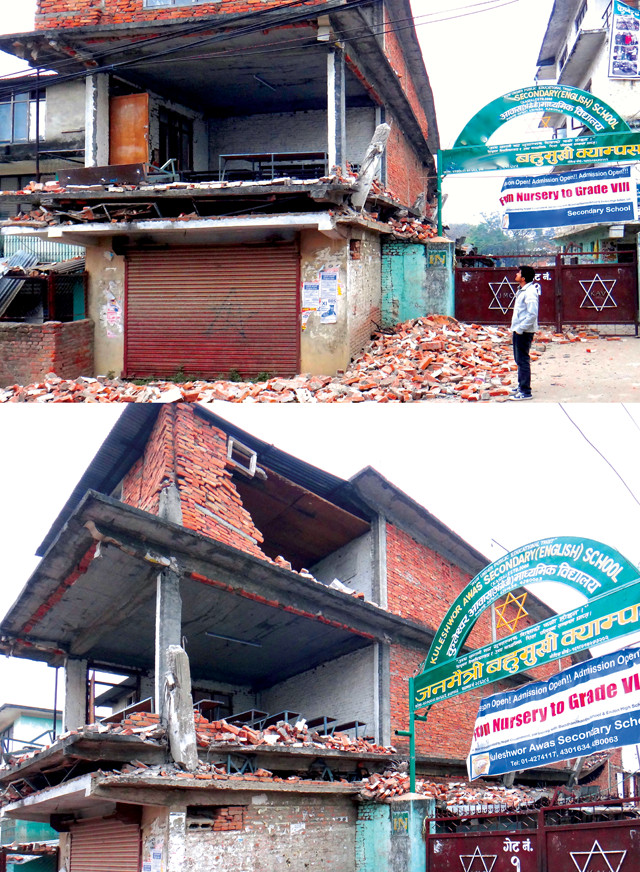
This school in Nepal collapsed during the 2015 magnitude-7.8 Gorkha earthquake. Blue metal schooldesks can be seen crushed between the pancaked floors. No students were present because the quake occurred on a Saturday. Credit: both: Anne Sanquini, GeoHazards International.
When the magnitude-7.8 Gorkha earthquake rocked Nepal on April 25, 2015, it destroyed 19,000 classrooms and damaged more than 30,000 others. The quake — in which nearly 9,000 people died and 22,000 others were injured — struck on a Saturday, when schools in Nepal are not in session. Still, more than 500 students and teachers died in collapsing school buildings, according to data from the Nepal Ministry of Education. Had those damaged classrooms been filled with students and teachers, the death toll would have been far higher.
Earthquakes can and do occur when students and teachers are in school buildings. In 2005, for example, when a magnitude-7.6 earthquake struck northern Pakistan and Pakistan-administered Kashmir, more than 19,000 children were killed, most in collapsing school buildings.
Damage to school buildings can also have other long-term repercussions for communities. “Education is a key component of a functional society,” says Janise Rodgers, chief operating officer of GeoHazards International, a nonprofit organization that helps vulnerable communities prepare for earthquakes, tsunamis, landslides and climate hazards. “The most severe effect of an earthquake is obviously when children and teachers are injured or killed, but even if they aren’t in school when an earthquake happens, education is disrupted if the school building is damaged.”
Keeping students and teachers safe during earthquakes, and ensuring that education is minimally disrupted after seismic events, are simple goals with complex solutions. Governments, researchers, schools, communities and other organizations tasked with pursuing these goals are working together to navigate the maze of financial, social and technical challenges.
ass=““caption”>Making effective decisions requires first classifying the problem. In 2009, nearly 75 percent of the more than 1.2 billion children enrolled in primary and secondary schools lived in areas of high seismic risk, according to a report on school seismic safety authored by the World Bank and several international partner agencies. For school districts in high seismic risk areas, allocating part of their finite resources to upgrade schools’ seismic resilience to make them safer for students and staff would seem intuitive, but this is far easier said than done.
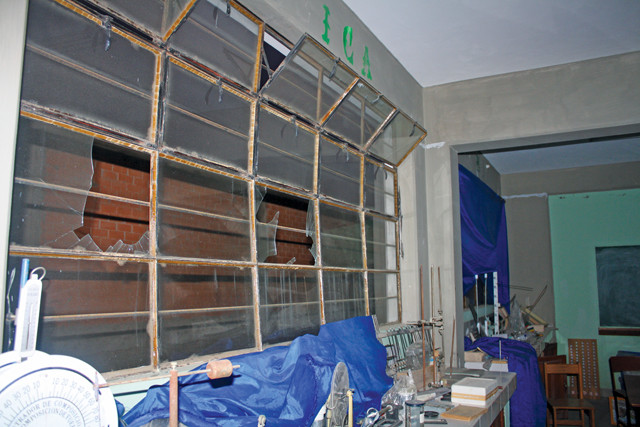
Windows and equipment in this school were damaged during the magnitude-7.1 earthquake that struck near Acari, Peru, on Sept. 25, 2013. Credit: Pontifical Catholic University of Peru.
ass=““caption”>One of the initial decisions is which schools to retrofit first, especially in places like Lima, Peru, where more than half of the almost 2,000 public schools are at “great risk” of being damaged by earthquakes, says Sandra Santa-Cruz, a civil engineer at Pontifical Catholic University in Lima. When so many schools are at risk from earthquakes, she says, and “time and economic resources are limited, and schools cannot be closed or stopped during the retrofit process,” it is difficult to decide where to start.
her hard decision is determining the extent a building should be retrofitted, says Carlos Ventura, a civil engineer at the University of British Columbia in Canada who has been working with the provincial government to assess and retrofit schools. British Columbia has about 1,600 public schools, more than 750 of which are located in areas of high seismic hazard. “With limited resources, do you retrofit and build to prevent collapse but have some structural damage after an earthquake, or do you try to ensure that there is no damage at all?” Ventura asks. Often, schools are also expected to act as shelters after natural disasters, he notes. “So, maybe you decide that only a part of the school — say the gym — will be used for shelter, and you build it so it doesn’t get harmed at all,” he says.
Making these decisions begins with assessing and estimating the risk of damage or collapse of specific school buildings by earthquakes, Ventura says.
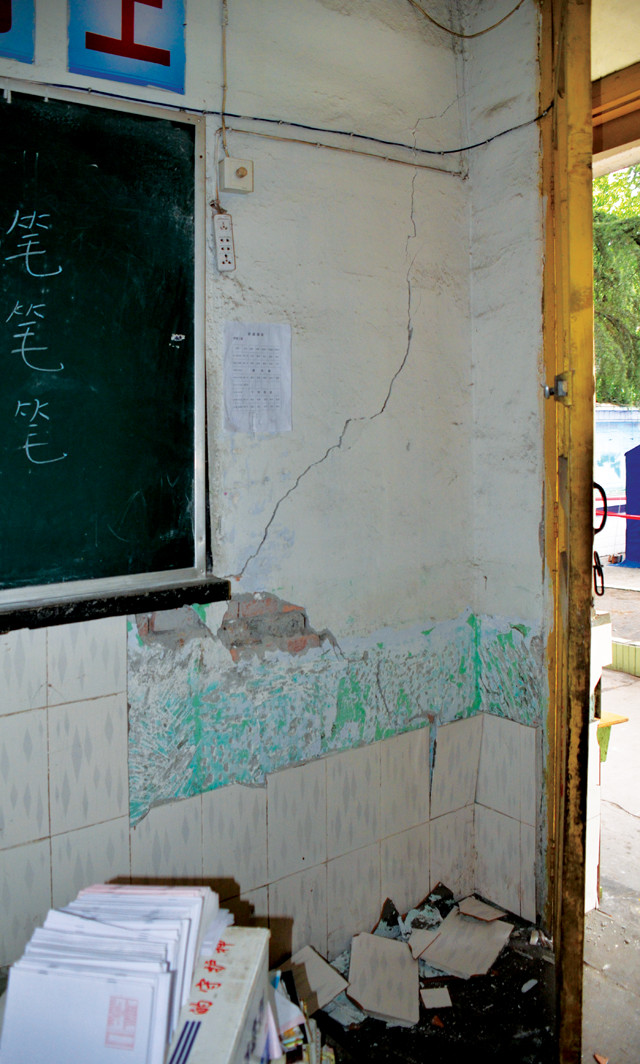
Guozhang Middle School was damaged during the 2013 Lushan quake near Sichuan, China, which killed nearly 200 people. Credit: Walter Mooney, USGS.
“Earthquake risk” is a combination of the natural hazard and the vulnerabilities of infrastructure and human systems. Consider Victoria, B.C., and Calgary, Alberta, two Canadian cities about 725 kilometers apart. “The seismic hazard in Victoria is very high, but low in Calgary,” Ventura says. “So if you have a very old school in Victoria and a similar building in Calgary, you have vulnerable buildings in both locations, but the risk of damage from earthquakes is very different” due to the significant earthquake hazard in British Columbia and very little hazard in Calgary, he says.
Calculating the seismic hazard for a particular location is a complex process with many variables, including local geologic features and soil types. Furthermore, not all earthquakes are created equal. British Columbia, for instance, can experience crustal, subcrustal or subduction earthquakes; crustal earthquakes tend to produce short, intense shaking whereas subduction earthquakes tend to produce continuous shaking that can last several minutes. “Geophysical parameters and structural response can vary substantially between these types of earthquakes. Therefore, the definition of seismic hazards for each type of earthquake is important [for seismic risk assessments],” Ventura wrote in a recent report on seismic retrofitting of schools in British Columbia.
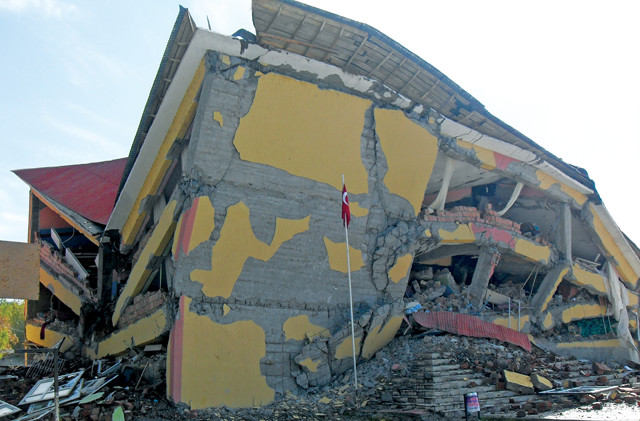
This school in Gedikbulak, Turkey, collapsed during the Oct. 23, 2011, magnitude-7.2 Van earthquake, which killed 570 people. Credit: Beyza Taskin, Istanbul Technical University.
The second big factor in seismic risk assessments is the buildings themselves. School buildings can vary tremendously in size and character, ranging from multistoried reinforced concrete buildings to single-room mud and stone structures. “Despite the disparities, many schools — especially in urban areas — tend to share similar characteristics, and as a result, similar seismic vulnerabilities,” Rodgers wrote in a 2012 paper presented at the World Conference on Earthquake Engineering.
For that study, Rodgers examined 32 reports of how earthquakes had damaged school buildings and 27 seismic assessments of schools around the world. She found that several factors, including school layouts, the construction materials and practices used, as well as nonstructural hazards — such as falling objects like loose ceiling tiles and hanging light fixtures — all contribute to the seismic vulnerability of schools.
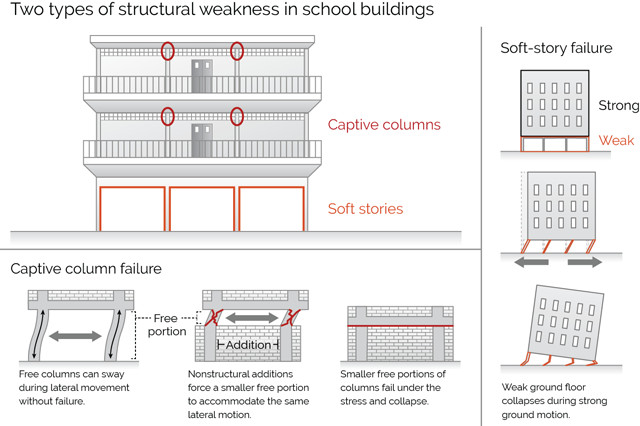
Two structural features that increase school vulnerability to earthquakes are captive, or short, columns, and weak first floors, both of which can lead to the collapse of "soft stories" and cause damage to the more rigid floors above. Credit: K. Cantner AGI.
Two structural features that increase school vulnerability are captive, or short, columns and soft stories. Captive columns are structural columns whose ability to deform during earthquakes is compromised unequally along their heights by other building features. For instance, schools often have large windows to let in natural light and air. In some cases, windows are located between structural columns, and the space below the windows is filled in with masonry walls. These walls “capture,” or restrict, the movement of the adjacent columns during an earthquake — forming “short columns” — while the parts of the columns above the walls and next to the windows have greater freedom of movement. This creates an “inadequate stiffness distribution in the structural column” and an inability to withstand lateral shear forces, which can lead to damage and sudden collapse during an earthquake, says Beyza Taskin, a civil engineer at Istanbul Technical University in Turkey. In addition to windows, other construction features, such as beams, girders or stairway landings, can also create captive or short columns. In Lima, short-column failures are the most common type of seismic damage seen in schools built before 1997, according to Santa-Cruz.
Seismic damage is also common in soft-story buildings, which feature one or more floors — often the ground floor, where seismic forces are strongest — that are significantly less rigid than the floors above it. For instance, schools with an open assembly hall on the first floor often have large, unreinforced spaces. Without seismic strengthening, soft-story structures are particularly susceptible to lateral ground motions during earthquakes, which can lead to extreme amounts of lateral displacement and cause the collapse of the soft stories and damage to the floors above.
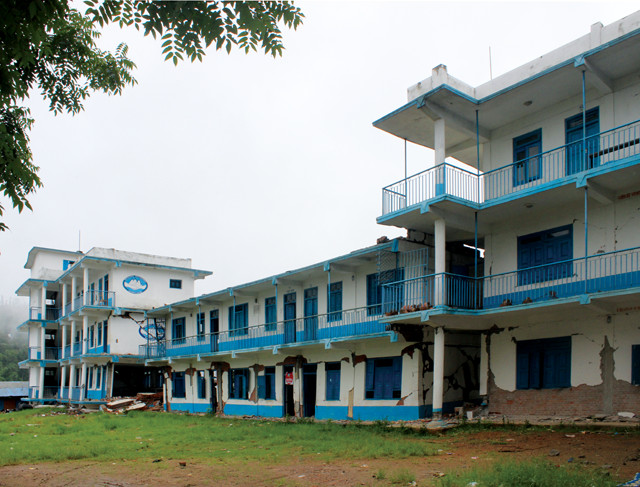
This school in Sindhupalchowk, Nepal, was damaged in the 2015 quake due to soft-story collapse. Credit: Dipendra Gautam.
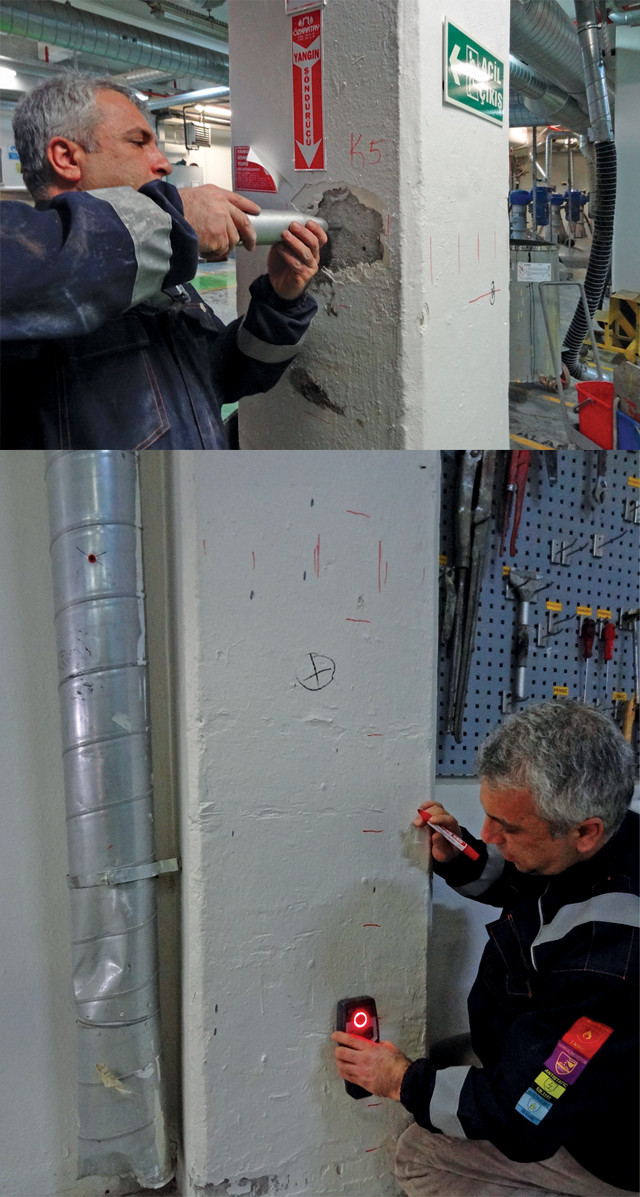
Above: Nondestructive testing to assess the seismic vulnerability of school buildings can include detecting the presence and placement of rebar as well as determining concrete strength. Credit: both: Beyza Taskin, Istanbul Technical University.
Older school buildings, especially, can have structural weaknesses that increase their seismic vulnerability. In seismically active areas in Italy, for example, “the concrete of [school] buildings erected before 1980 is often of inadequate quality; and insufficient anchoring and overlapping lengths of steel bars are frequently detected in reinforced concrete buildings,” says Antonio Formisano, a professor of structural engineering at the University of Naples Federico II in Italy.
Another factor that can exacerbate school seismic vulnerabilities is that governments and school authorities often use standard structural designs for schools. If seismic vulnerabilities exist in a standard plan, every school building constructed using that plan will be susceptible to damage from earthquakes. Additionally, if a design isn’t customized to the local soil conditions and physical characteristics of a particular site, it could lead to site-specific vulnerabilities that wouldn’t otherwise exist in ideal settings.
“Determining the individual structural characteristics of every [school] building is a must,” Taskin says.
Tests to assess the seismic vulnerability of school buildings can include destructive sampling, such as sampling concrete to measure its strength and other characteristics, and nondestructive sampling, such as testing for the number and placement of reinforcing steel bars inside concrete. “Taking specimens can be disruptive because of the dirt and noise generated during the process,” Taskin says. “But the findings of nondestructive tests should be calibrated with experimental destructive methods.”
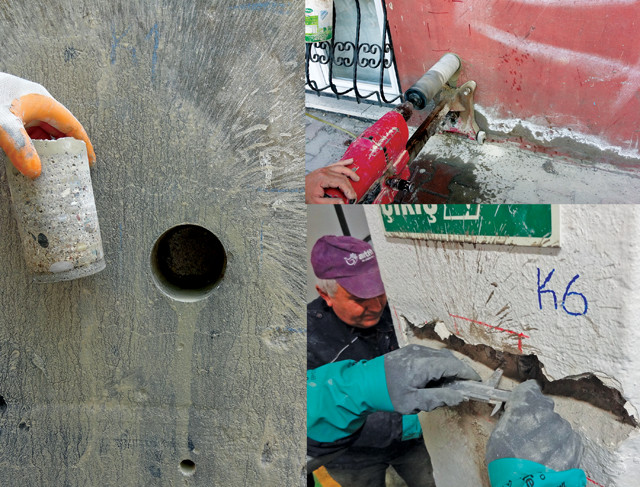
Sampling concrete to measure its strength and other characteristics , as shown in the three images above, is a destructive testing method that also helps in assessing the seismic vulnerability of school buildings. Credit: all: Beyza Taskin, Istanbul Technical University.
Such testing is a complicated, time-consuming task for a single school, let alone testing hundreds or thousands of schools. In Istanbul, which lies in a high seismic hazard zone, there are more than 3,000 elementary and high schools, creating a backlog, Taskin says. “Considering the limited holiday time that can be used for on-site measurements and the high [cost], vulnerable schools can be put on long waiting lists,” she says.
But knowing the structural characteristics of school buildings is important in determining how vulnerable the buildings are to earthquakes. Researchers can simulate these characteristics in computer models to analyze how the ground and buildings move during different kinds of earthquakes, how that movement stresses structural and nonstructural components in school buildings, and how those buildings respond to those stresses. These are all key factors in accurately assessing, and working to minimize, seismic risk.
Around the world, schools plan and prepare for various risks, both from human activities — anything from playground accidents to armed attacks — and from natural disasters like tornadoes, hurricanes and earthquakes. These risks compete for attention and resources, and school administrators must make decisions about which threats to prioritize. Gauging the seismic risks faced by different schools can help governments and communities decide which schools to focus on first. One such prioritization effort is the Seismic Mitigation Program initiated by the government of British Columbia in 2004. As part of this program, Ventura and others have been using the combination of earthquake hazard and school building vulnerability to rank schools according to the level of risk they face from earthquakes.
arthimage src=“group_VancouverSchool2_MOE_CCBYNCND20.jpg” caption=“The new Crosstown Elementary School in downtown Vancouver, B.C., is state-of-the-art in many regards, including having been built with seismic safety in mind. Credit: both: British Columbia Ministry of Education, CC BY NC-ND 2.0.” >}}
As of mid-2017, 346 of the 1,600 schools in the province were characterized as high risk, with 165 of those schools either strengthened or replaced, and 14 more in some phase of strengthening or construction. Projects to retrofit more than 50 other schools are in development. Specific seismic retrofits vary depending on the type of school building. For instance, “many older schools are unreinforced masonry buildings, which are fairly brittle structures,” says John Sherstobitoff, a structural/seismic engineer at Ausenco and a member of the seismic peer review committee involved in the Seismic Mitigation Program. To strengthen these buildings, concrete shear walls, which help counter the lateral forces exerted by earthquakes, and steel plates, which anchor the existing buildings’ structural components to the shear walls, are commonly added. More innovative techniques, such as “base isolation” — in which the structure of a building is effectively “unlinked” from the ground, and therefore the lateral forces exerted by earthquakes are significantly reduced — can better protect brittle buildings and also offer heritage preservation, Sherstobitoff says. Recently, a school in Vancouver became the first school — and first building — in Canada to be retrofitted with a base-isolation system.
Local conditions can also influence which retrofit techniques are used. In many parts of British Columbia, soil liquefaction during earthquakes, where the soil suddenly behaves like a liquid, poses significant risks to structures, including school buildings. The Seismic Mitigation Program also addresses buildings on liquefaction-prone sites, Sherstobitoff says. To date, structural retrofit solutions, such as connecting foundations together and adding supplemental columns where existing columns may fail, have been used, he says.
arthimage src=“BCEQsafety_ProvinceofBC_CCBYNCND20.jpg” caption=“Since launching the Seismic Mitigation Program in 2004, the government of British Columbia has spent more than .5 billion to modify schools at high seismic risk. The program includes retrofitting 346 schools, 235 of which are completed or in progress. Credit: Province of British Columbia, CC BY NC-ND 2.0.” >}}
In Lima, a collaborative project among the Peruvian Ministry of Education, the World Bank and the Global Facility for Disaster Reduction and Recovery generated seismic hazard maps and collected school vulnerability data to identify schools most at risk from earthquakes. Seismic intervention projects are now underway in 252 of the most at-risk schools. The Ministry of Education, along with partner organizations, also aims to retrofit more than 42,000 schools serving 2.2 million students across Peru that were built before 1997 and are at risk of short-column failure during earthquakes. Techniques such as adding steel braces and additional concrete framing can help strengthen these schools.
The Italian government is also working to increase the seismic safety of older buildings, including schools, by instituting mandatory assessments and retrofits. For new construction, building codes aimed at minimizing damage from earthquakes are in place in most parts of the world today.
arthimage src=“earthmagfig1_draft1.jpg” caption=“Built in 1891, Strathcona Elementary School in Vancouver was seismically updated with a base-isolation system and other retrofits. The yellow line shows the location of the isolation plane. Credit: Ausenco.” >}}
But building codes are not enough to ensure the safety of recently built and future schools, says Lucy Arendt, who studies risk management and organizational decision-making at St. Norbert College in Wisconsin. “Because building codes exist, people assume that newer buildings are safe,” she says. “Unfortunately, building codes are more of a minimum; very rarely are they [written] in such a way that buildings will be fully safe in all situations.”
Even when codes are adequate on paper, financial limitations, insufficient quality control, unskilled or untrained construction workers, and even corruption and politics can lead to the use of poor-quality materials or shoddy craftsmanship in the construction of schools (and other buildings), Arendt says.
arthimage src=“IMG_0836.jpg” caption=“The foundation of the school had to be sawed through entirely, as shown here, at the isolation plane to insert the isolation bearings. Credit: Heatherbrae Construction.” >}}
But that doesn’t mean schools cannot be made safer against seismic damage. In May 2008, a magnitude-8 earthquake hit China’s Sichuan province, causing more than 7,000 schoolrooms to collapse, killing more than 5,000 students and injuring almost 15,000 more. One school that remained standing was Sangzao Middle School, located about 150 kilometers north of Sichuan’s capital, Chengdu. The school’s principal, Ye Zhiping, had successfully lobbied for funds from local authorities to reinforce the school building, including widening and inserting iron rods into the school’s concrete pillars. All 2,323 students survived the Sichuan earthquake, and they and their parents credit the reinforcements.
It remains unclear why so many schools collapsed during the Sichuan earthquake, but the fact that the Sangzao Middle School and its students and staff survived the earthquake, when so many other schools did not, highlights an important disconnect: While the means and technology to improve school seismic safety already exist in many parts of the world, they are often not implemented effectively.
Choices, Choices, Choices
“Who doesn’t want to protect children and keep them safe?” Arendt asks. It’s a rhetorical question, she says, but it leads to another crucial question: How can communities ensure that children are not only safe but also thriving when resources are limited? “We have to decide how to allocate those limited resources to try to achieve best possible outcomes.”
Safe school buildings are vital to effective education systems, but so are engaged and expert teachers, access to appropriate study materials, and, in many places, the ability of schools to provide nutritious meals. Often, the drive to fulfill important immediate needs overrides investments in key long-term safety features.
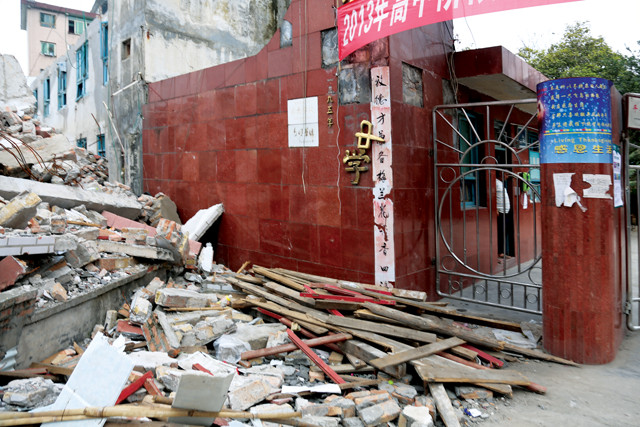
Guozhang Middle School, damaged during the 2013 Lushan quake near Sichuan, China. Credit: Walter Mooney, USGS.
“The question facing decision-makers can actually appear to be: ‘What is more important … up-to-date textbook[s] and good laboratory facilities now or a building that can withstand an extreme event which might or might not occur within the next few decades?’” wrote Marla Petal, a risk reduction, resilience and education consultant with Save the Children Australia, and colleagues in a 2015 contribution to the Encyclopedia of Earthquake Engineering.
Earthquakes threaten all structures democratically, leading to tough choices for communities about which buildings to prioritize for safety measures. Do you prioritize retrofitting a school or a hospital, for example, or a bridge or a natural gas line?
Consider also the relative cost-effectiveness of investing in safer schools compared to investing in other aspects of social or community welfare. For instance, in areas of the world “where child and infant mortality is high, basic vaccinations are not universal, or safe domestic water and sanitation facilities are inadequate, the relative ranking of school safety as a cost-effective public health intervention may be low,” Petal and her colleagues wrote.
Having multiple groups involved in improving seismic safety in schools, including governments, nongovernmental organizations, construction companies and community members, in addition to parents, teachers, staff and students, makes settling on seismic fixes a challenge. Finding consensus can be difficult, Arendt says. These people all share the broad goal of increasing seismic resilience of schools, but they can “interpret goal statements differently, have different values, change their views over time, and may or may not have access to the information and resources needed to achieve [their] goals,” Arendt and others wrote in a 2012 volume entitled “Natural Hazard Mitigation Policy.”
arthimage src=“Peru-SafeSchool.jpg” caption=“Schools in Peru, like this new construction in the Arequipa region, are deemed essential infrastructure in the new seismic code. Robust columns should help the school avoid damage during occasional earthquakes (those with a 75-year return period), and it is expected that the school should remain operative even through rare larger events (with a 475-year return period). Credit: Pontifical Catholic University of Peru.” >}}
Schools in Peru, like this new construction in the Arequipa region, are deemed essential infrastructure in the new seismic code. Robust columns should help the school avoid damage during occasional earthquakes (those with a 75-year return period), and it is expected that the school should remain operative even through rare larger events (with a 475-year return period). Credit: Pontifical Catholic University of Peru.[/caption]
ass=““caption”>Partnerships aimed at effectively enhancing school earthquake safety can look very different in different parts of the world.
ritish Columbia, the Ministry of Education partnered with the Association of Professional Engineers and Geoscientists of British Columbia and the University of British Columbia, including Ventura, “to leverage the skillset of experts in the field to create seismic assessment and retrofit guidelines,” says Michael Nyikes of the British Columbia Ministry of Education.
re are always advances in technology and research and that can change the parameters of assessment and retrofit, and we want to make sure we are continuing to evolve as knowledge and research advances,” Nyikes says.
eru, local authorities have focused on the structural issues of school buildings, “but if we don’t take into account the social aspects of safe schools, we won’t invest resources optimally,” Santa-Cruz says. “We have to keep researching approaches that increase the resilience of schools against earthquakes and other hazards both effectively and cost-efficiently because current protective measures can be very expensive, and we cannot use them for schools on a large scale.”
a-Cruz is working on combining traditional “top-down” approaches, such as government-mandated school retrofits, with community-based endeavors. This more holistic approach has uncovered challenges to improving school seismic safety, especially in parts of Lima that have grown without much urban planning or government oversight. Schools in these parts of the city are often built by pooling resources from community members, making ownership of the schools, or the land they are built on, unclear. Murky ownership can hamper procurement of government funds for retrofitting work or even delay relief efforts after earthquakes. By working together, government officials and community members can more quickly establish ownership of these schools and move on to strengthening them against natural hazards.
are changing our idea of what risk reduction can be, and we are doing this by listening to each other and involving more stakeholders and community members in our discussions to have more comprehensive ideas,” Santa-Cruz says.
In countries like Peru and Nepal, where communities have traditionally been heavily involved in school construction, not involving them during retrofitting efforts can backfire and endanger the very people the measures were meant to protect.
“Communities have been the primary implementer of school construction projects in Nepal,” wrote Rebekah Paci-Green, director of the Resilience Institute at Western Washington University, in a 2016 paper in the International Journal of Mass Emergencies and Disasters. “Local school committees typically serve much like construction managers by convincing landowners to donate a suitable site, enlisting volunteer laborers, hiring a limited number of skilled laborers, and tracking purchases and construction processes.”
Paci-Green has studied school seismic safety projects in Nepal, comparing projects with solely technical components to others that combined technical and community engagement approaches. In general, schools that were retrofitted performed better during the 2015 earthquake compared to schools that weren’t. However, the safest schools were those where technical interventions had been wedded with efforts to engage and involve the community.
arthimage src=“7662-nepalquake1_ADB_CCBYNCND20.jpg” caption=“The Shree Bhagawati Higher Secondary School in Sankhu Bazar served as a refuge after the 2015 Nepal quake. The school was one of the buildings retrofitted under Nepal’s school safety program and one of 160 such retrofitted school buildings in the Kathmandu Valley that withstood the quake. Credit: Samir Jung Thapa, Asian Development Bank.” >}}
of the schools Paci-Green examined had been retrofitted by the Nepalese Ministry of Education and the World Bank, and survived the earthquake with minimal damage. But the community had been minimally involved in the project, so the teachers were skeptical. “We asked the teachers how they would have responded if school was in session during the earthquake,” Paci-Green says. “They told us that they would have instructed the students to run out of the building; those who were on the second floor would have been told to jump out of windows or off of balconies. They weren’t part of the retrofitting effort and they didn’t trust what the government had done.”
The National Society for Earthquake Technology in Nepal, a nonprofit organization, tries to bridge the gap between retrofitting efforts and community engagement. For instance, they train local masons on ways to build earthquake-resistant schools using local materials.
The impact is huge, Arendt says. “These masons are part of the local community and are trusted by community members.” They can explain what they are doing to parents, teachers and students, and use their expertise to increase the earthquake resistance of other buildings in the community as well, she says.
“Retrofitting and building safe schools are vital, but they are one pillar of school earthquake safety,” Paci-Green says. In the end, she says, “comprehensive school safety has to involve educating and engaging the community as well.”
© 2008-2021. All rights reserved. Any copying, redistribution or retransmission of any of the contents of this service without the expressed written permission of the American Geosciences Institute is expressly prohibited. Click here for all copyright requests.